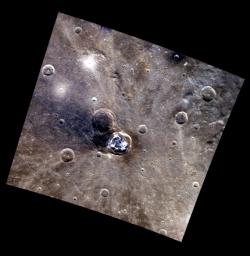
|
Balanchine’s Blues
- Click the image above for a larger view
- Full-Res JPEG (1329 x 1362) (209.4 kB)
- Full-Res TIFF (1329 x 1362) (5.4 MB)
Caption:
The crater at the center of this scene is named for choreographer George Balanchine, as the beautiful swath of diffuse blue ejecta emanating from the crater might remind one of the famous blue tutus in one of Balanchine's most well known ballets, Serenade . What caused this asymmetric pattern of ejecta? One possibility might be that it formed in part atop a similarly sized, preexisting impact crater. This older crater excavated the lower reflectance blue deposit from beneath the surface, part of which was then redistributed by the impact that formed Balanchine. The cracks visible in the lower left of the image are part of the complex system of graben that cut the floor of the Caloris basin, in which Balanchine in located. North is up in this image.
This image was acquired as a high-resolution targeted color observation. Targeted color observations are images of a small area on Mercury's surface at resolutions higher than the 1-kilometer/pixel 8-color base map. During MESSENGER's one-year primary mission, hundreds of targeted color observations were obtained. During MESSENGER's extended mission, high-resolution targeted color observations are more rare, as the 3-color base map covered Mercury's northern hemisphere with the highest-resolution color images that are possible.
Date acquired:
June 29, 2011
Image Mission Elapsed Time (MET):
217863931, 217863927, 217863923
Image ID:
441964, 441963, 441962
Instrument:
Wide Angle Camera (WAC) of the Mercury Dual Imaging System (MDIS)
WAC filters:
9, 7, 6 (996, 748, 433 nanometers) in red, green, and blue
Center Latitude:
39.05°
Center Longitude:
175.8° E
Resolution:
282 meters/pixel
Scale:
Balanchine crater is approximately 38 km (24 mi.) in diameter
Incidence Angle:
39.6°
Emission Angle:
6.3°
Phase Angle:
40.9°
Background Info:
The MESSENGER spacecraft is the first ever to orbit the planet Mercury, and the spacecraft's seven scientific instruments and radio science investigation are unraveling the history and evolution of the Solar System's innermost planet. MESSENGER acquired over 150,000 images and extensive other data sets. MESSENGER is capable of continuing orbital operations until early 2015.
For information regarding the use of images, see the MESSENGER image use policy .
Cataloging Keywords:
| Name | Value | Additional Values |
|---|---|---|
| Target | Mercury | |
| System | ||
| Target Type | Planet | |
| Mission | MESSENGER | |
| Instrument Host | MESSENGER | |
| Host Type | Orbiter | |
| Instrument | Mercury Dual Imaging System (MDIS) | |
| Detector | Wide Angle Camera (WAC) | |
| Extra Keywords | Color, Crater, Impact, Map, Radio | |
| Acquisition Date | ||
| Release Date | 2013-05-17 | |
| Date in Caption | 2011-06-29 | |
| Image Credit | NASA/Johns Hopkins University Applied Physics Laboratory/Carnegie Institution of Washington | |
| Source | photojournal.jpl.nasa.gov/catalog/PIA17057 | |
| Identifier | PIA17057 | |
